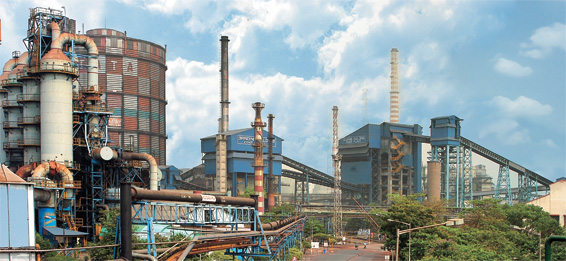Management Discussion and Analysis
III) Risk Management

Tata Steel has adopted the framework of
Corporate Sustainability Management System
and triple bottom line performance reporting
that facilitates the Company’s efforts to
proactively manage concerns and address the
needs beyond compliance to norms. |
Risk Management is a structured and disciplined approach
to manage enterprise risk. The Company recognises Risk
Management as an integrated, forward looking and process
oriented approach for managing all key business risks and
opportunities. The Company’s Risk Management process is based
on the framework of the Tata Business Excellence Model.
In translating the Company’s vision and mission into specific
strategies, objectives and priorities, each business unit of the
Company addresses opportunities and the attendant risks
through an institutionalised approach that is aligned with
the Company’s objectives. The Managing Director, Deputy
Managing Directors and the Business Heads (Vice Presidents
and Executives-in-Charge) manage risks on a daily basis through
cross functional involvement and intense communication
across businesses. The Risk Management process commences
with the preparation of the Long Term and Annual Business
Plans and managing the performance of the business in
conformity to the above Plan.
The Company reviews, monitors and manages risk under the
following broad category:
Strategic Risks
The Steel Industry today faces several significant strategic issues
which include, inter alia, industry consolidation issues, execution
of profitable growth options, raw material linkages and security,
technology and new product development, raising finance
from global financial markets, protecting the environment and
serving the community while creating value for its shareholders.
The Management of the Company prepares the long term
strategic plans taking into account the long term objectives
of the Company. The Executive Committee of the Board and
the Board of Directors of the Company periodically review the
strategic plan of the Company taking into account the changes
in the global steel industry and advise the management on
various strategic issues. The Company undertakes its growth
projects including acquisitions based on the strategic plan
approved by the Board.
Business and Operational Risk
The management of the Company headed by the Managing
Director is responsible for managing the day to day affairs of
the Company.
The Company has adopted the framework of Corporate
Sustainability Management System and Triple Bottom Line
performance (Economic, Environmental, and Societal)
reporting. This facilitates the Company’s efforts to proactively manage concerns and address the needs beyond compliance
to norms. The Company’s goals of ensuring safety, improved
quality of life and environmental sustainability are cascaded
down the organisation through the deployment of its
Environmental, Health & Safety Policy.
The steel industry is still highly fragmented and cyclical in
nature as well as demand for steel products is generally
affected by macroeconomic fluctuations in the global markets.
The Company has undertaken several initiatives to insulate
itself from volatility in steel prices by continuously enriching
its product mix and moving up the value chain, branding
its products and entering into long term contracts with
its customers. The Company is relatively protected from
increases in the prices of key raw materials since it meets
100% of iron ore and around 70% of coal requirements from
its captive mines.
The impact of Company’s products, services and operations
on employees, society and environment are systematically
analysed through stakeholder engagement, “risk analysis”
under ISO-14001, OHSAS-18001 and “Life Cycle Assessment”
of products.
The Company has taken number of initiatives to mitigate
risks arising from concentration risk at a single location in
Jamshedpur. The overseas acquisitions of NatSteel Asia Pte.
Ltd. having presence in seven countries of South-East Asia and
Tata Steel (Thailand) Public Company Ltd. were steps taken
in this direction. Further, beside expanding steel capacity in
Jamshedpur, the Company is also executing greenfield projects
in Orissa, Chhattisgarh and Jharkhand in foreseeable future.
The Company has taken a Mega Insurance Policy to insure
all its operating assets against property damage, business
interruption losses due to fire and allied perils (such as fire,
explosion, earthquake, flood, storm etc.) and terrorism damages.
The Company has also taken a Comprehensive General
Liability Insurance and Product Liability Insurance. The risks are
periodically reviewed by the top management to ascertain
the adequacy of coverage and if required, corrective action
is taken to mitigate the risks to levels considered acceptable
by the Company.
Implementation of a robust communication process across the
organisation is a key element of the Risk Management process.
There are various communication forums in the Company which
provide a platform to the entire cross section of employees
to raise and discuss various operational issues relating to the
performance of the Company.
Growth Execution Risk
All capital investment proposals are evaluated and reviewed
based on the Investment Management Process of the Company.
The proposals are evaluated by the Investment Management
Committee headed by the Managing Director against benchmark
criteria for investments including Hurdle Rate, Fitment Criteria for
Strategy and Performance and criticality before being put up for
the approval of the Executive Committee of the Board and the
Board of Directors. Major capital projects are also subject to post
completion review by the Corporate Audit for effectiveness of
these investments. The Company periodically submits the status
report of all major projects before the Executive Committee of
the Board and the Board of Directors.
Acquisitions & Post Acquisition Integration
The Company pursues acquisition opportunities as per its long
term strategic plans approved by the Board. All acquisition
proposals are evaluated by the Board. The Senior Management
of the Company reviews the integration process and provides
guidance to the integration teams for realisation of targets and
creating value from the acquisitions. The Company has made
significant progress in integrating NatSteel Asia Pte. Ltd. and
Tata Steel (Thailand) Public Company Ltd. through formation
of various integration committees and work-streams. To
facilitate the integration of Tata Steel and Corus, a Strategic
and Integration Committee has been formed to facilitate the
integration process.
Financial Risk
The Company actively monitors Foreign Exchange and Interest
Rate exposure. Based on an informed view and assessment of
these risks, it has developed a Risk Management Policy. The
Risk Management policy of the Company operates to achieve
greater predictability of earnings and provides a stable planning
environment.
The Company actively and selectively hedged its export
receivables and import payables during the last financial year.
The Company drew down USD 1.65 billion of foreign currency
loans on its Balance Sheet during the year and retained the
funds in liquid and highly rated foreign currency fixed deposits
prior to their deployment in order to minimise negative carry. As
part of the competitive bid process for the acquisition of Corus
Group plc, the Company was required under the UK Takeover
Code to provide “certainty of funds” in Pound Sterling. For this
purpose the Company made use of financial derivatives to
minimise risk during the transaction period.
The Company endeavours to pursue the following long-term
financing objectives as part of its Strategic Plan:
Various communication forums in
the company provide a platform
to employees to raise and discuss
operational issues relating to the
performance of the Company. |
- Raising cost efficient funds for the growth plans of the
Company
- To be an Investment grade Company in the long-term
- To provide financial flexibility in the Balance Sheet
- Funding strategy to focus on EPS accretion
- To comply with the expectations of various lenders in terms
of financial covenants
The Company was featured as the “Corporate Risk Manager of
the Year” by Asia Risk magazine in its October 2006 issue.
Statutory Compliance
On obtaining confirmation from the various units of the
Company of having complied with all the statutory requirements,
a declaration regarding compliance with the provisions of the
various statutes is made by the Managing Director at each Board
Meeting. The Company Secretary, ensures compliance with SEBI
regulations and provisions of the Listing Agreement. The Chief
Financial Officer, as the Compliance Officer for prevention of
insider trading ensures compliance with the Tata Guidelines on
Insider Trading.
Contingent Liabilities
Details of contingent liabilities are given in Schedule M of the
Notes on Balance Sheet and Profit and Loss Account.

TOP |